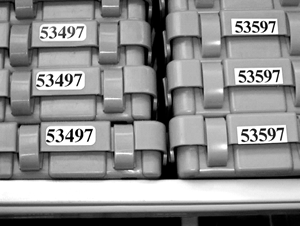Digital Transition Advisory Committee reviews implementation of digital talking-book system
Talking-book player production, distribution, training on schedule
A demonstration of the digital talking-book system was the high point of the Digital Transition Advisory Committee meeting at NLS on March 27–28, 2008.
The committee, consisting of representatives from consumer groups, libraries for the blind and physically handicapped, and the Chief Officers of State Library Agencies organization, convened to review plans for implementation of the digital talking-book system.
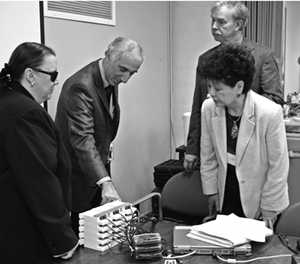
NLS director Kurt Cylke announced the completion of the digital-player and flash-
cartridge design phase and the commencement of the production stage. He stated that NLS is currently reviewing proposals for the manufacture of both the digital talking-book players and flash cartridges. Expectations are that awards will be made by late spring.
"The Library of Congress has the world’s largest and most diverse audiobook collection," said Cylke. "We are anxious to bring the collection to patrons on machines that have great sound and many accessible features."
Michael Katzmann, chief of the Materials Development Division, demonstrated production models of both the basic and advanced players and of talking-book flash cartridges. Participants were invited to explore the players’ many features. When they inserted flash cartridges into the machines, the players announced their status— "player on"—or functions—"rewind" or "fast-forward."
The players were designed for long-term maintainability and durability, Katzmann explained. "They are mechanically easy to repair and may be fixed by people who are blind or have low vision." Estimated life expectancy of the machines is fifty-seven years and the keyboards, cables, and batteries are replaceable.
Katzmann told the advisory committee that implementation of the digital system will begin with a manufacturing production test of 200 players, followed by a field test of 5,000 players, and then production of 12,000 to 15,000 players each month. In the second year of production, NLS staff expects to contract for the manufacture of about 175,000 machines, and, depending on cost, 110,000 each year thereafter.
The new digital players will be distributed to veterans first and then to network library patrons who are 100 years of age or older, according to Judith Dixon, NLS consumer relations officer. Individual libraries serving blind and physically handicapped readers are encouraged to set their own distribution policies after they have served these groups.
Deborah Toomey, NLS network consultant, said that planning is underway to ensure that staffs of cooperating libraries are prepared to train patrons and resolve any problems that may arise. Richard Smith, director of the Wolfner Library for the Blind and Physically Handicapped, Jefferson City, Missouri, said he was "comforted" by this news.
According to Neil Bernstein, research and development officer, 2,000 patrons have access to the pilot digital audiobook download site, which makes 10,000 books available to eligible users who own authorized commercial players. Patrons may download a maximum of 30 books per month and have downloaded 58,000 titles since the pilot site opened.
Director of the Massachusetts Board of Library Commissioners Robert Maier closed the meeting saying, "I want to thank NLS for not only listening in the last committee meeting, but for acting on our ideas."
China Braille Press visits NLS
An eight-person delegation from the China Braille Press (CBP), the sole publisher of braille books in China, and the Chinese government visited NLS in Washington on January 28.

Zheng Wei, editor in chief of CBP, and Han Zhongyi, the vice president of CBP, described their agency’s fifty-five-year history. He explained that China also has government-funded libraries. "But the number of book titles available to blind people in China is still relatively small compared to the blind population," said Zheng. "China Braille Press is an organization similar to your organization in that we work with government and state officials to promote the welfare of blind people." CBP staff members were particularly interested in the process and cost of braille production as they are conducting research on printing braille using regular laser printer paper.
CBP offers seven thousand braille book titles available to the Chinese population in approximately five million copies. Tang Lizhen, the CBP director of technology, also demonstrated the Easy Speaker, an MP3 player the size of a mobile phone that the CBP research department worked with blind people to develop. The Easy Speaker converts text to speech in Cantonese, Mandarin, and English and has voice-guided tone and speed controls.
CBP was established in 1953 and is now an agency of 175 employees in 17 departments. CBP offers braille books and journals, talking books, large-print books, assistive technology, and other informational products, as well as three types of services: a free braille-lending system, cultural research, and nonprofit social programs.
Zheng said, "We have come to learn from the best; we are here to study your way of service."
Frank Kurt Cylke provided a summary of NLS’s mission and history, and explained plans for launching the digital talking-book system. "You are visiting at a momentous time in our history," said Cylke.
NLS Network Division chief Carolyn Sung gave an overview of the NLS network of cooperating libraries. Sung also explained the library standards of service developed in conjunction with the American Library Association and Association of Specialized and Cooperative Library Agencies.
Judith Dixon, NLS consumer relations officer and an authority on braille, answered the visitors’ questions concerning the blind population living in the United States and the cost of producing braille books and magazines. Noting that the statistics are estimates because there is no requirement to register or survey the blind people in America, Dixon said that approximately 5 million blind people reside in the United States, about 100,000 of whom are braille readers. Zheng commented that the numbers in China were also estimates. "There are 16 million blind people in China; 800,000 can read braille," he said.
NLS Materials Development Division chief Michael Katzmann later spoke about manufacturing braille and audiobooks. He explained the production process and the development of the ANSI/NISO 239.86 standard, then demonstrated a prototype of the digital talking-book machine.
The visit to NLS was part of a CPB’s multi-city tour of U.S. braille producers and services. The group had already visited the National Braille Press in Boston and left to visit the American Printing House for the Blind in Louisville, Kentucky, the following day.
Libraries pioneer alternative shelving methods
Most NLS network regional libraries have been shelving audiocassettes by book number since NLS began distributing them more than thirty years ago. Unlike public libraries, where fiction is usually shelved by the author’s last name, many NLS libraries locate all titles by their unique book numbers. Numerical shelving has also proved an efficient way to accommodate NLS book receipt and circulation. Although the transition to digital talking books and players will not require regional libraries to adopt an alternative shelving method immediately, most will find either terminal-digit or random (expanded turnaround) shelving useful during the transition and necessary by 2012.
Terminal-digit shelving: New York
The Andrew Heiskell Braille and Talking Book Library in New York City embraced terminal-digit shelving in 2000 to accommodate the vast number of books coming in from NLS and the finite amount of space available at the library. "Every other year we would do a huge shift and it occurred to me that there had to be a better way to do this," said Bonnie Farrier, assistant regional librarian. After brainstorming about alternatives to numerical shelving, she realized that books could be weeded and shifted much easier by section as opposed to the entire collection at once. She concluded that books could be shelved by their terminal digits.
Terminal-digit shelving is based on the last two digits of each book number. The stacks are divided into one hundred sections numbered 00 to 99. Books are shelved according to the last two digits of their RC numbers and then are broken down by the preceding numbers within the shelves. For example, RC 56199 would be shelved with RC 42899 in section 99. RC 61521, RC 48321, and RC 32421 would be shelved together in section 21.
Terminal-digit shelving has a number of immediate advantages as well as long-term benefits. Since NLS assigns book numbers in numerical order, a library that uses terminal-digit shelving will benefit from a more evenly distributed collection. As the sections fill with titles, weeding and shifting can take place at any time. And since each section is 1/100th of the entire collection, it takes less time to weed and shift. According to Farrier, "One person can weed a section in an hour and one person can shift a section in less than thirty minutes." Weeding and shifting the collection by section does not disrupt the general placement of other titles, an important feature when regional libraries are mandated to keep at least one copy of every NLS title.
The long-term benefits of terminal-digit shelving are not immediately apparent. "In the long run not every library will have a copy of every book and so they will need to think about shelving in a different way," said Steve Prine, assistant chief of the NLS Network Division. NLS will soon begin issuing digital books (DBs) with the same book numbers as cassette books, but with a different prefix. Since the DB cartridge container was designed with the same footprint as the RC cassette container, the two formats can be shelved together. Numerical shelving will accommodate the intershelving of DBs and RCs at first, but in 2010 when NLS plans to phase out RCs, and then in 2012 to recall older, less-circulated DBs for reuse, libraries will have to decide how to use the empty spaces on the shelves. By using terminal-digit shelving, spaces become available on the shelves and then fill as new DBs or RCs are produced and received.
Making the switch
Once the planning phase was complete, converting the shelving system from numerical to terminal digit took the Andrew Heiskell Braille and Talking Book Library staff nearly two weeks. "We hired a moving company to handle clearing the stacks, storing the books, and reshelving," said Farrier. "And since we had to close for two weeks, we tried to ship as many books as possible to our patrons before the move." When circulation had ceased and the shelves were cleared, staff worked to relabel the shelves with the terminal-digit numbers 00 through 99 and to manually change the shelf location codes in the Keystone database system. Books were then reshelved based on their terminal digits. "Brief staff training was needed," said Farrier, "but it only took a few trips to the stacks for everyone to learn the arrangement."
Random shelving: Texas
With an annual circulation of almost 800,000 RCs—more than 6,000 items a day—and a warehouse the size of a football field full of audiobooks, the Texas State Library and Archives Commission had to find an efficient way of shelving and retrieving its collection. "For years the library wasn’t automated. So when it was time to become automated we thought,
because of the size of the collection in proportion to the staff, that random shelving would work," said Ava Smith, regional librarian.
Many libraries use a turnaround system (or holding area) to manage popular titles. When books are returned to the library, staff members inspect them and then place them on the turnaround shelf randomly. Approximately 80 percent of the titles on the turnaround shelf will go out the following day. So when the shipping staff prints the mailing cards for the next day, many of the titles are ready to go out from the turnaround shelf and do not need to be retrieved from the stacks.
Random shelving is sometimes called "expanded turnaround" because it works in much the same way. Instead of using a numerical approach to shelving the titles, this method relies on a computer system to track and manage the location of books. The stacks are divided into ranges, units, shelves, and piles. The ranges are broken down into areas for active books (AA–AR) and areas for less active books (AS–AZ). Within the ranges are sections; each range has ninety-nine sections. Within the sections are piles and shelves—eight books to a pile and five piles to a shelf. Books are placed on the shelves in no particular order but the computer system knows each book’s location. "People hear ‘random’ and they think ‘chaos.’ But even though books are not put on the shelves in a preassigned place, our system is set up to track them," said Smith.
Books returned to the library are inspected but not sorted. Staff members use a scanner to alert the system to the location of the shelf and then scan all the books in that location. Once all the books in a section have been scanned, staff members turn the books so that the title ID or RC number is facing outward, making pulling books easier and alerting other staff members that the section has been scanned. The library doesn’t have a designated turnaround area because the ranges that hold the active books are received from circulation so frequently that they come to the front of the shelving sections. These in effect become turnaround shelving.
When a title needs to be pulled and shipped to a patron, the computer system prints out a bookcard that identifies the title’s location on the shelves. For example, RC 62853 has a location code of AB521103 on the card. The code alerts staff that the book is in the AB range, section 52, shelf 11, and pile 03. The staff can then pull the title from its location, insert the bookcard, and place the title on the cart for shipment that day. All titles on a cart for shipment are scanned into the system’s check-out program. The program unlinks the book from the shelf and links it with the patron ID number. Once all titles have been scanned into the system they are ready for shipment.
As large gaps appear on the shelves, the staff can shift an entire section in about fifteen minutes. When there are few books left on a shelf, the staff can gather all the books from that shelf and move them to the end of the aisle, tell the computer to unlink all the books from that shelf, and then rescan all the items on the shelf on which they placed the books. The shelf from which the books were removed is then open for returns.
When weeding, a staff member asks the computer how many copies of a title have circulated over a certain period of time. If the staff member decides to weed some of the copies, the computer will identify the location of those that are most circulated. "We tried to automate what a person would do if he or she were to weed the collection," said Smith.
Using this method of shelving provides a large circulation and storage capacity and has many immediate benefits including a reduction of materials handling by eliminating the need to shift an entire collection, to sort or presort returns, and to shelve in sequence to maintain order. Random shelving also reduces space requirements, encourages automated weeding, and easily accepts new books received out of numerical sequence. The computer system manages and tracks the storage and circulation of books.
In the long run, random shelving will accommodate multiple audiobook media and the NLS recall of less-used digital books. "At some point every library that employs sequential numerical shelving will have blank spaces on their shelves," said Prine. But libraries that adopt an alternative shelving method, like random shelving, will be able to place a book on the shelf and allow the computer system to track it.
Converting to random shelving
The idea of converting a numerical shelving method to random makes a lot of people nervous but, according to Smith, doing so is quite simple. "You just pick a section and start bar coding. All the sections will randomize themselves as time goes by," she said. As books circulate and leave gaps in the shelves, staff members can shift the sections. And as time goes by the less-circulated items will end up toward the back of the collection.
Random shelving requires a computer system with sophisticated programming and scanners loaded with the proper applications. Different bar-code systems need to be placed on the books and the shelves so that the system can track the location of each book—whether it be on a shelf or in a patron’s home. "For this to work you have to have two bar codes: one on the book and one on the shelf. Then you have to be able to link the bar codes to the system," said Smith.
Changes ahead
As NLS adjusts to the changes in the talking-book program that come with the conversion to digital, network libraries will need to embrace some modifications of their own. "Each library should evaluate its individual circulation and resources and make a decision about which method will best suit its needs," said Prine. "An alternative shelving method will make things easier for shipping and receiving staff."
Network exchange
Cooking without Looking gets a boost from Florida regional library
Florida’s Bureau of Braille and Talking Book Library Services has sponsored episodes of Cooking without Looking, a television series for people who are blind or visually impaired, as part of its statewide public outreach campaign. The series has been broadcast on PBS in Palm Beach, Broward, and Miami counties, and may be picked up by other PBS stations in the future.

There are twenty-four episodes taped to date, according to Renée Rentmeester, creator and producer of the show and the head of Vision World Foundation, a Florida nonprofit that helps disabled people on an individual basis. "We have completed our second season, and we’ll begin the third season when we get more funding."
Cooking without Looking has three permanent hosts that guide each episode: Celia Chacon, who is blind, and Annette Watkins and Allen Preston, who are visually impaired. All three help a guest host teach the audience how to prepare a meal, demonstrating cooking techniques to help visually challenged people stay safe in the kitchen. Though the program is geared toward blind and visually impaired people, Rentmeester believes that more than half of those who tune in to it are sighted. "We want to show all the different kinds of impairments and how we can all work together to learn to be independent—I’ve learned tips from the program, too."
The series is taped out of the WXEL studio in Boynton Beach, Florida. "We use the production team and we edit the show there," said Rentmeester. "We taped an episode at a remote location in Daytona Beach and that was fun. We want to do more remote locations in our next season."
Each segment welcomes a guest cook. Rentmeester doesn’t seek out the guests—they come to her. "People around the country hear about the program and they call with suggestions for shows. When they come to Florida to visit family or to vacation, they tape a show segment. Guests have come from Pennsylvania, Arizona, Michigan, and New York. We haven’t turned down anyone yet!"
Funding for Cooking without Looking comes from several sources. The first season was underwritten by Nova Southeastern University School of Optometry; the second season by Magnify America, which provides visual aids to people with low vision. The Florida Division of Blind Services (DBS) has sponsored some episodes as part of its statewide public outreach campaign. During each show that DBS sponsors, the PBS station plays two fifteen-second public service announcements, one that promotes the general services provided by DBS and the other an NLS-produced spot with Rita Moreno. Some sponsors, such as American Express and Envision America, also sign on to fund production of individual shows.
The series is available to national and international viewers at no cost. "Some people said I should charge for these programs," said Rentmeester, "but I want as many people to see the shows as possible." Cooking without Looking is picked up in Malaysia, Great Britain, and Australia.
Mauricio Guaiana, a Vision World Foundation board member who lives and works in Brazil, engaged a graphic arts company that does work for his company to build and maintain the foundation’s web site.
To view Cooking without Looking, visit the Vision World Foundation web site at www.visionworldfoundation.net and select Streaming Video. To order free copies, contact Vision World Foundation at 1-888-290-7005 or e-mail Renée Rentmeester at reneeadvt@aol.com.
Georgia employees reach PINNACLE
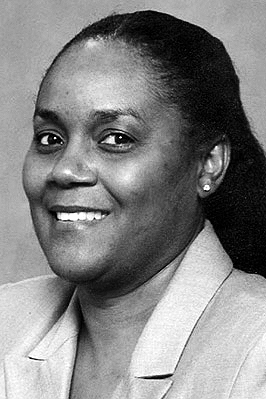
Beverly Williams, subregional manager for the Georgia Library for Accessible Services (GLASS), is among the twenty professionals selected to participate in the inaugural class of the Public Library Institute for New and Creative Leadership Education (PINNACLE), in Atlanta, Georgia. Stella Cone, GLASS director, is one of the program’s ten mentors.
The goal of PINNACLE, created by Georgia Public Library Services, is to ensure the quality of library leadership in the state of Georgia. Participants must be current employees of a public library in the state of Georgia, have two years of professional experience, and have a master of library science or other professional library degrees.
PINNACLE kicked off in November 2007 with a weeklong retreat held at Unicoi State Park near Helen, Georgia. During the course of a year, the participants will attend eight monthly two-day sessions for leadership and management training in analytical and creative problem solving, performance measures, conflict and group dynamics, media relations, and other areas. Participants will also receive individual counsel from the ten mentors, each of whom will work with two program members.
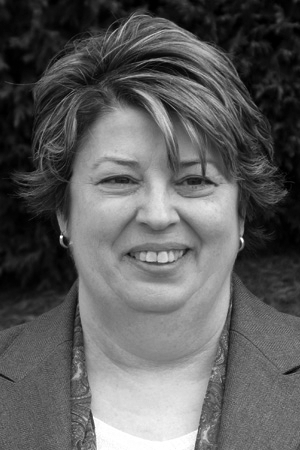
Williams has been working at GLASS since May 1999. She hopes that her PINNACLE experience will help her to be a more focused and confident leader. "As a part of our yearlong training, we are required to complete a significant self-directed learning project during the program that we will present at the Georgia Library Association/Council of Media Organization conference in November 2008," said Williams. "I have decided to focus on working with public libraries in providing accessible workstations."
Illinois’s Bersche gets Skrzypek Award
Karen Bersche, director of Mid-Illinois Talking Book Center, received the Alexander J. Skrzypek Award, which recognizes leadership in the advancement of library services for blind or physically disabled people in Illinois, on October 11, 2007.
"Karen approaches her job with creativity and enthusiasm," says Sharon Ruda, Illinois State Library Talking Book and Braille Service director.
Alexander Skrzypek (1905–1976) was one of the first librarians for the blind in the United States, serving at the Chicago Public Library for fifty-one years. He was instrumental in publicizing and working for the passage of the Pratt-Smoot Act.
Illinois State Library director Anne Craig, along with Skrzypek’s son and grandson, presented the award to Bersche.
South Carolina opens art gallery
South Carolina State Library’s Talking Book Services Library held a ribbon-cutting ceremony and reception on March 12, 2008, for the grand opening of its art gallery.

The gallery displays artwork created by visually impaired and blind K–12 students from across the state. "The idea to display student artwork was a result of conversations with the South Carolina School for the Deaf and the Blind," said Pamela Davenport, director of Talking Book Services. "The gallery’s aim is to promote and provide access to art for visually impaired and blind people."
All visitors are encouraged to touch the artwork, which includes wall hangings and sculpture.
Braille Institute honors patrons, authors
More than 525 patrons and guests attended the Braille Institute of America’s star-studded open house in Los Angeles on October 18, 2007. Attendees were welcomed by the Angel City Chorale, an internationally acclaimed, multicultural ensemble of 120 men and women, singing "Ain’t That Good News."
Braille Institute director Henry Chang began the ceremonies by presenting the Golden Cassette Award to Frank Kurt Cylke for his leadership and vision in providing digital talking books to the blind and physically handicapped community. NLS Materials Development Division chief Michael Katzmann accepted the award on behalf of the director and then discussed the progress of the digital talking-book project. "The talking-book program is poised to take a revolutionary turn in technology; however, its core purpose remains unchanged," he explained.
Katzmann reviewed the design process for the digital talking book and player and demonstrated a prototype of the machine. He said, "We have learned from patrons, librarians, and our many volunteer repair technicians, so that we now have a machine design that will not only be a pleasure to use, but will be durable and easy to maintain."
Discussing the highlights of the player, Katzmann said, "The new machine will make reading easier and more intuitive. An entire book will fit on a single cartridge. No more switching sides and swapping cassettes." He briefly touched on the NLS digital download pilot program, and concluded that whatever the funding situation, the talking-book program will remain a partnership between the federal government and local libraries to provide personal service to patrons. "Whether delivered by the mailman or the Internet, this will not change. It is the wonderful work of the Braille Institute Library that we celebrate here today."
The audience was also treated to readings from two authors. Janet Fitch, author of the international bestseller and Oprah Book Club Selection White Oleander, read a selection from her newest work Paint It Black. Then Newbery Award winner Sid Fleischman read to twenty-five children from his much-loved book The Whipping Boy. Mystery/thriller writer Robert Levinson, who is the author of many popular titles including Where the Lies Begin and The James Dean Affair, also greeted participants.
Patron Laura Simon, who turned 102 years old in November, also received a Golden Cassette Award. Simon, a vivacious artist, writer, and conversationalist, is the author of I Am Still Here, a detailed account of her life as she progressed from her childhood to the present. "The Braille Institute Library Services has been a great help to me. The volunteers who work there are very astute," said Simon. "It was a privilege and an honor to receive the Golden Cassette Award and to meet the authors and other speakers."
King named director of WTBBL;
Leonard to retire at the end of the year
Danielle H.M. King became the director of Washington Talking Book and Braille Library (WTBBL) on April 28, 2008.
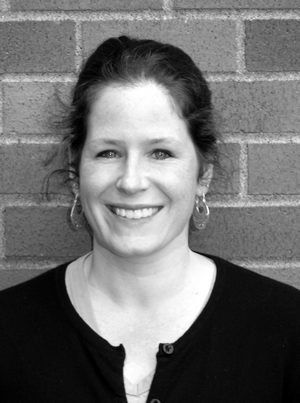
King has a masters of library and information science from the University of Washington, where she has also completed doctoral course work in information science. Prior to joining the WTBBL staff she served as the access services manager at the University of Washington’s Odegaard Library.
"I’m looking forward to being an advocate for the WTBBL and working with community stakeholders and leaders to define a new vision," said King.
King’s appointment coincides with the transition of WTBBL from the Seattle Public Library to the Washington State Library, a division of the Office of Secretary of State. The Washington State Library will assume direct administration and operation of the WTBBL on July 1, 2008.
Gloria Leonard, who has served as director since 2002, will retire at the end of 2008. She will assist with the transition of operations to the state until June 30. "My six years of working with the National Library Service for the Blind and Physically Handicapped headquarters and network libraries has been the most rewarding part of my thirty-six-year career as a librarian," said Leonard.
Carnegie Library wins AARP Award
The Carnegie Library of Pittsburgh, Library for the Blind and Physically Handicapped (LBPH), received the 2007 AARP Excellence in Service to Older Adults Award for its Outreach to Seniors program, which sends library staff to locations throughout western Pennsylvania to promote talking books.

The program, now duplicated in other states, was funded by a state grant. LBPH director Kathleen Kappel says the idea to use a mobile unit to spread the word has been in her head for more than ten years. "We wanted to find a way to tell seniors about the services provided by LBPH other than through a brochure," she said. "We needed to get out and take information on the library’s services to the people."
The number of readers who will be eligible for services provided by the Carnegie Library is projected to increase by 11 percent over the next decade.
The library’s van is outfitted with reading equipment, audiobooks, large-print books, narrated videos, and laptop computers. The outreach staff includes a professional with a degree in social work, a volunteer nurse who screens prospective talking-book readers for eligibility, and librarians who demonstrate the talking-book equipment, explain the book selection and distribution system, and sign individuals up for the program.
The mobile unit visits senior centers, schools, community events, "and wherever we are asked to go," said Kappel. "Because of the popularity of the outreach program, we have more requests than we can handle."
John Wilkinson retires after thirty-three years at NLS
John Wilkinson, NLS literary braille advisor, retired on January 3 , 2008, after thirty-three years of service.
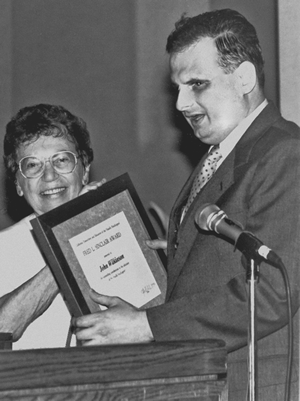
"John has been an invaluable member of the NLS staff," said Frank Kurt Cylke. "With his strong work ethic and personable nature, he has trained thousands of people to become braille transcribers and proofreaders over the past three decades."
According to NLS consumer relations officer Judith Dixon, Wilkinson has trained nearly five thousand transcribers and proofreaders. "And the transcribers and proofreaders love him," she said.
The only child of an auto mechanic from rural Virginia and a coal miner’s daughter from West Virginia, Wilkinson was the first blind student in the state of Maryland to go through all twelve grades of public school, graduating from High Point High School in Prince George’s County. He went on to study music at American University and received his Bachelor of Music Education, summa cum laude, in 1973, specializing in voice and piano.
"I had known about NLS since graduating from high school in Prince George’s County. I was a patron and would get music scores for piano and vocal pieces," said Wilkinson. "[NLS government information and volunteer specialist] Freddie Peaco used to help me get books in braille or on tape, and if they weren’t available, she would help find a volunteer to transcribe them.
"Teaching jobs weren’t available when I finished college," he added. "A friend of mine knew Charles Galozzi, who was the NLS director at that time, and she told him about me. There were no immediate openings, but I met with Galozzi and Maxine Dorf [then supervisor of training specialists in the Volunteer Services Section] later told me that they would call when a position opened and I could apply."
On April 1, 1975—"April Fool’s Day," Wilkinson joked—he received a job offer. He was hired to work in the Volunteer Training Section, later called the Braille Codes Section, then Braille Development. In his role as literary braille advisor, Wilkinson’s primary responsibility was grading lessons and trial manuscripts for people who were enrolled in the braille transcription program. He also answered complex questions from transcribers, teachers, and proofreaders via phone or e-mail, evaluated lessons and certified proofreaders, and wrote the student-instructor dialog column for the NLS newsletter Update.
Wilkinson’s skills were not limited to training. He also transcribed White House and congressional documents from print to braille and translated documents from braille to print. "These were usually letters generated from the White House or Congress that were to be sent to blind individuals, or a letter from a constituent in braille that needed to be translated into print," Wilkinson explained.
In 1994, Wilkinson received the Fred L. Sinclair Award from the California Transcribers and Educators of the Visually Handicapped for Outstanding Contributions to the Education of the Visually Impaired, an honor given only occasionally to individuals who merit special recognition. During the award presentation, he was cited as "the nation’s number one braille emergency helper at the other end of the 800-number."
Wilkinson also served on the Braille Authority of North America’s Literary Braille Technical Committee from 1988 to 2007.
During his retirement, Wilkinson plans "to travel some and pursue my music." An avid sports fan, he is also looking forward to following his favorite teams: the Washington Redskins, Nationals, Wizards, and Capitals.
Mother’s jewelry line promotes braille literacy
Leslie Ligon, a Denton, Texas, mother of two, has turned her vision of promoting braille literacy into a reality by designing, producing, and selling jewelry. Her jewelry line, At First Sight, features beads with braille characters.
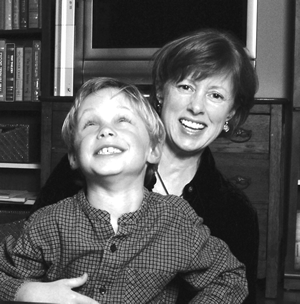
Ligon started the line ten years ago, after she took her two-month-old son in for a well-baby visit. "The doctor said, ‘Brace yourself: I don’t think Ethan can see,’" recalled Ligon. A specialist determined Ethan’s retinas had detached. Surgery to reattach them was unsuccessful.
Ligon and her husband set out to learn as much about braille as they could, and "we were astonished to find that as few as 10 percent of people who are blind or visually impaired read braille," she said.
"When I first began designing and making jewelry, I noticed many items incorporated Balinese-style, almost braille-like beadwork," explained Ligon. "Since Ethan was immersed in braille for his first year, it was always around us. I started thinking about creating a fun line of braille fashion jewelry; something that combined the aesthetics of design and functionality of braille to attract people to it."
Ligon started shopping the idea around to wholesale jewelers, without success. She was selling her pieces in a local coffee shop when two men approached her and explained that they were mass-production jewelers from China. After sharing her ideas with them and explaining what braille was, they told her, "If you can draw it, we will make it."

After failed attempts at transferring design ideas via telephone and the Internet, Ligon flew to China in January 2000 and had 2,000 braille heart pendants manufactured just before Valentine’s Day.
She now has an online shop at www. braillestone.com and sells her jewelry at conferences and symposiums around the country. She donates a percentage of her profits—$10,000 to date—to organizations that share her goal, including Braille Without Borders, National Braille Press, and BrailleInk.
"My intention is to promote braille literacy by offering fun jewelry," said Ligon. "By playing with the visual element of braille, I hope to introduce the lyrical quality, as well as the importance of it."
Ligon’s pieces have braille on the front, regular print engraved on the back.
The Program
The National Library Service for the Blind and Physically Handicapped of the Library of Congress publishes books and magazines in braille and in recorded form on discs and cassettes for readers who cannot hold, handle, or see well enough to read conventional print because of a temporary or permanent visual or physical handicap.
Through a national network of state and local libraries, the materials are loaned free to eligible readers in the United States and to U.S. citizens living abroad. Materials are sent to readers and returned by postage-free mail.
Books and Magazines
Readers may borrow all types of popular-interest books including bestsellers, classics, mysteries, westerns, poetry, history, biographies, religious literature, children's books, and foreign-language materials. Readers may also subscribe to more than seventy popular magazines in braille and recorded formats.
Special Equipment
Special equipment needed to play the discs and cassettes, which are recorded at slower than conventional speeds, is loaned indefinitely to readers. An amplifier with headphone is available for blind and physically handicapped readers who are also certified as hearing impaired. Other devices are provided to aid readers with mobility impairments in using playback machines.
Eligibility
You are eligible for the Library of Congress program if:
- You are legally blind--your vision in the better eye is 20/200 or less with correcting glasses, or your widest diameter of visual field is no greater than 20 degrees;
- You cannot see well enough or focus long enough to read standard print, although you wear glasses to correct your vision;
- You are unable to handle print books or turn pages because of a physical handicap; or
- You are certified by a medical doctor as having a reading disability, due to an organic dysfunction, which is of sufficient severity to prevent reading in a normal manner.
How to Apply
You may request an application by writing NLS or calling toll-free 1-800-424-9100, and your name will be referred to your cooperating library.
News is published quarterly by:
National Library Service for the Blind and Physically HandicappedLibrary of Congress
Washington, DC 20542
All correspondence should be addressed to the attention of Publications and Media Section. To change address or cancel subscription, please enclose mailing label.
Editor: Ingrid Davitt
Writers: Lina Dutky, Paula Higgins, Dorothy Hill, Sabreen Madyun, and Casandra Middleton.
